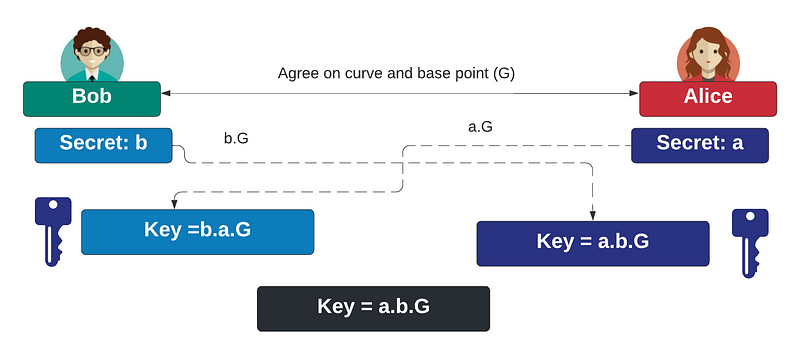The Method That Protects You The Most From Spying On The Internet: ECDH

The Method That Protects You The Most From Spying On The Internet: ECDH
So, what’s the method that protects your privacy online virtually more than any other method? Well, that is likely to be the might ECDH (Elliptic Curve Diffie Hellman) method. So, let’s implement it for all the possible elliptic curve methods.
With ECDH (Elliptic Curve Diffie Hellman), Bob generates a scalar value of b and Alice generates a scalar value of a. Bob computes b.G and Alice computes a.G, and where G is the base point on the curve. Bob passes b.G to Alice, and Alice passes a.G to Bob. They then both compute a.b.G as a shared secret. In this case, we will use a number of standard curves to produce the shared secret.

First we create a folder named “bc_ec03”, and then go into that folder.We can create a Dotnet console project for .NET 8.0 with:
dotnet new console --framework net8.0Next we can install the Bouncy Castle library with:
dotnet add package BouncyCastle.Crypto.dll --version 1.8.1Next some code [here]:
namespace ECCurves
{
using Org.BouncyCastle.Asn1.X9;
using Org.BouncyCastle.Security;
using Org.BouncyCastle.Crypto.Parameters;
class Program
{
static void Main(string[] args)
{
var curvename="secp256k1";
if (args.Length >0) curvename=args[0];
try {
X9ECParameters ecParams = ECNamedCurveTable.GetByName(curvename);
var curveparam = new ECDomainParameters(ecParams.Curve, ecParams.G, ecParams.N, ecParams.H, ecParams.GetSeed());
Org.BouncyCastle.Crypto.Parameters.ECKeyGenerationParameters keygenParams = new Org.BouncyCastle.Crypto.Parameters.ECKeyGenerationParameters (curveparam, new SecureRandom());
Org.BouncyCastle.Crypto.Generators.ECKeyPairGenerator generator = new Org.BouncyCastle.Crypto.Generators.ECKeyPairGenerator("ECDSA");
generator.Init(keygenParams);
var keyPair = generator.GenerateKeyPair();
var BobprivateKey = (ECPrivateKeyParameters) keyPair.Private;
var BobpublicKey = (ECPublicKeyParameters) keyPair.Public;
// var BobpublicKey = ecParams.G.Multiply(BobprivateKey.D);
var keyPair2 = generator.GenerateKeyPair();
var AliceprivateKey = (ECPrivateKeyParameters) keyPair2.Private;
var AlicepublicKey = (ECPublicKeyParameters) keyPair2.Public;
// var AlicepublicKey = ecParams.G.Multiply(AliceprivateKey.D);
var ShareKeyAlice = BobpublicKey.Q.Multiply(AliceprivateKey.D);
var ShareKeyBob = AlicepublicKey.Q.Multiply(BobprivateKey.D);
Console.WriteLine("== Curve: {0} ",curvename);
Console.WriteLine("\n Bob Private key === ");
Console.WriteLine("== D_b={0} ",BobprivateKey.D.ToString());
Console.WriteLine("\n Bob Public key === ");
Console.WriteLine("== Q_x={0} ",BobpublicKey.Q.AffineXCoord);
Console.WriteLine("== Q_y={0} ",BobpublicKey.Q.AffineYCoord);
Console.WriteLine("\n== Alice Private key === ");
Console.WriteLine(" D_a={0} ",AliceprivateKey.D.ToString());
Console.WriteLine("\n== Alice Public key === ");
Console.WriteLine(" Q_x={0} ",AlicepublicKey.Q.AffineXCoord);
Console.WriteLine(" Q_y={0} ",AlicepublicKey.Q.AffineYCoord);
Console.WriteLine("\n\n== Shared key === ");
Console.WriteLine(" Shared key (Bob) ==={0} ",ShareKeyBob.Normalize().AffineXCoord);
Console.WriteLine(" Shared key (Alice) ==={0} ",ShareKeyAlice.Normalize().AffineXCoord);
Console.WriteLine("\n\nCurve details: G={0}, N={1}, H={2}", ecParams.G, ecParams.N, ecParams.H);
Console.WriteLine("A={0}\nB={1}\nField size={2}",ecParams.Curve.A,ecParams.Curve.B,ecParams.Curve.FieldSize);
} catch (Exception e) {
Console.WriteLine("Error: {0}",e.Message);
}
}
}
}
}A sample run for secp2561 gives [here]:
== Curve: secp256k1
Bob Private key ===
== D_b=104440660231868095396729365161125744441732891662618747308192395954925556452661
Bob Public key ===
== Q_x=f2b12dd1bee1262ac0104d75a927918469c801f7714bd2777d3f37e061a7da7a
== Q_y=2580bd44df0618df9ea4897384b55020e671cdd9a029f5501d7c94fafe7b3324
== Alice Private key ===
D_a=37691210022027421675390073679228940555709453553957591812838571855334943714279
== Alice Public key ===
Q_x=73f6bc668a95ef0c835cffae2cf3c32a80bdde40f17c2ce2c83eed0f662f58de
Q_y=557e983f400c47002fedf9f515607cb4c072739448a170aa71ec4655612ad9c3
== Shared key ===
Shared key (Bob) ===5ddb4213ee3b2fd663ce681c6bc8010aab42f3229e2479e59b6af8babf846615
Shared key (Alice) ===5ddb4213ee3b2fd663ce681c6bc8010aab42f3229e2479e59b6af8babf846615
Curve details: G=(79be667ef9dcbbac55a06295ce870b07029bfcdb2dce28d959f2815b16f81798,483ada7726a3c4655da4fbfc0e1108a8fd17b448a68554199c47d08ffb10d4b8,1,0), N=115792089237316195423570985008687907852837564279074904382605163141518161494337, H=1
A=0
B=7
Field size=256We see we have a shared secret of “5ddb4213ee3b2fd663ce681c6bc8010aab42f3229e2479e59b6af8babf846615”, and which is the x-coordinate point of the shared point (abG). And for NIST (FIPS) P-256:
== Curve: P-256
Bob Private key ===
== D_b=14396998444177855214832276087174687118195290575531943149305766547256278170161
Bob Public key ===
== Q_b=(a1fe64a9e7e4ffee4c25d3b6dd4f86bdb7a808d30cd227e0076a169ca6b39a23,f87f8a2f2f5318f4538464cdd8f1583d43c5f585f0f495a43ada8939f9935cf0,1,ffffffff00000001000000000000000000000000fffffffffffffffffffffffc)
== Alice Private key ===
D_a=43409290524029651895132107402409201272456245443545075570599407853849715049771
== Alice Public key ===
Q_a=(1b774bffcc89e26d0e0b764f6c1cc3b0e2186337b17ac63dfe6f7406e9a61966,888a9cba5f3a2cd5e4ef908c4015bff2bdb2288510a034f8e68beea31fa003c3,1,ffffffff00000001000000000000000000000000fffffffffffffffffffffffc)
== Shared key ===
Shared key (Bob) ===3a8decbe96075773b59cf55adb85062cc08e2b11158e2b43ed74f2db0011b927
Shared key (Alice) ===3a8decbe96075773b59cf55adb85062cc08e2b11158e2b43ed74f2db0011b927
Curve details: G=(6b17d1f2e12c4247f8bce6e563a440f277037d812deb33a0f4a13945d898c296,4fe342e2fe1a7f9b8ee7eb4a7c0f9e162bce33576b315ececbb6406837bf51f5,1,ffffffff00000001000000000000000000000000fffffffffffffffffffffffc), N=115792089210356248762697446949407573529996955224135760342422259061068512044369, H=1
A=ffffffff00000001000000000000000000000000fffffffffffffffffffffffc
B=5ac635d8aa3a93e7b3ebbd55769886bc651d06b0cc53b0f63bce3c3e27d2604b
Field size=256Conclusions
ECDH is beautiful and fundamental to our on-line security.